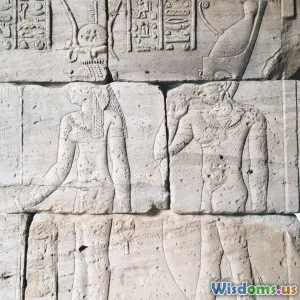
Unraveling Ancient Scripts and Their Significance
6 min read Explore the importance of ancient scripts and their role in understanding civilizations. (0 Reviews)
Unraveling Ancient Scripts and Their Significance
Throughout history, ancient scripts have served as the backbone of human communication, preserving the thoughts, beliefs, and stories of civilizations long gone. From the hieroglyphics of Egypt to the cuneiform of Mesopotamia, these writings offer a glimpse into the lives of our ancestors, providing context and clarity to archaeological discoveries. This article explores various ancient scripts, their significance, and the mysteries they still hold today.
The Role of Ancient Scripts
Ancient scripts are not merely collections of symbols; they are the narratives of human existence. They encapsulate the evolution of language, the development of societies, and the transmission of knowledge. Scripts served various purposes, including:
- Record-Keeping: Many ancient civilizations used scripts to maintain records of transactions, legal matters, and events. For example, the Sumerians developed cuneiform around 3200 BCE primarily for economic transactions.
- Cultural Expression: Scripts facilitated the expression of art, religion, and philosophy. The Egyptian hieroglyphs, for instance, were intricately tied to their religious beliefs and rituals.
- Communication: Scripts enabled communication across vast distances and among diverse groups. This was crucial for trade, diplomacy, and cultural exchange.
Key Ancient Scripts and Their Significance
1. Egyptian Hieroglyphs
Dating back to around 3100 BCE, Egyptian hieroglyphs are among the most recognized ancient scripts. Consisting of over 700 symbols, they were used primarily for religious texts and monumental inscriptions. The Rosetta Stone, discovered in 1799, was pivotal in deciphering these hieroglyphs, allowing scholars to unlock the history and culture of ancient Egypt.
2. Cuneiform
Developed by the Sumerians, cuneiform is one of the earliest known forms of writing, emerging around 3200 BCE. Initially used for accounting purposes, it evolved to encompass literature, law, and science. The Epic of Gilgamesh, one of the oldest known literary works, was inscribed in cuneiform, providing insight into the values and beliefs of Mesopotamian society.
3. Chinese Characters
Chinese writing, which dates back to around 1200 BCE, has evolved remarkably while retaining roots in ancient scripts. The complexity of Chinese characters reflects the cultural and philosophical depth of Chinese civilization. Understanding these characters today still connects us to thousands of years of history.
4. The Indus Script
The Indus Valley Civilization, flourishing from 3300 to 1300 BCE, produced a script that remains undeciphered. Found on seals and pottery, the Indus script consists of symbols that have puzzled linguists and archaeologists alike. Its significance lies in what it represents about the society's complexity and the ongoing quest for understanding this ancient culture.
5. Mesoamerican Scripts
Civilizations such as the Maya developed intricate writing systems that conveyed complex ideas and historical events. The Maya script, composed of logograms and syllabic signs, was crucial in documenting their history, astronomy, and mythology. The deciphering of Maya glyphs has opened new avenues for understanding their advanced civilization.
The Impact of Deciphering Ancient Scripts
The decipherment of ancient scripts has profoundly impacted our understanding of history. Each breakthrough, like the deciphering of the Rosetta Stone or the Maya glyphs, reveals layers of cultural significance and societal structure. These findings not only enhance our knowledge of specific civilizations but also illuminate the interconnectedness of human experience across time.
The Mysteries That Remain
Despite significant advancements, many scripts still hold mysteries that challenge scholars. The Indus script, for instance, remains undeciphered, leaving a vast gap in our understanding of the Indus Valley Civilization. Similarly, the Etruscan script and the Rongorongo of Easter Island continue to intrigue researchers, representing both a challenge and an opportunity for future discoveries.
Conclusion
Ancient scripts are more than mere symbols; they are keys to understanding the rich tapestry of human civilization. Each script carries stories of triumph, conflict, culture, and belief, connecting us to our ancestors in profound ways. As we continue to unravel their mysteries, we not only gain insights into the past but also enrich our understanding of humanity's shared journey. The ongoing study of these scripts promises to uncover new chapters in the story of our species, reminding us of the enduring power of written language.
Rate the Post
User Reviews
Popular Posts





















